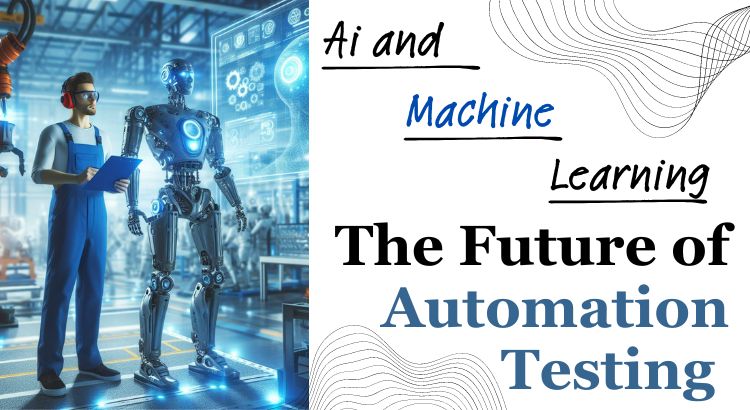
Automation testing has evolved a lot in recent years. But still, it requires a little human interference. Which means a small amount of human effort is required. But what if I say that little effort will be optional? Yes, that is true. Artificial Intelligence and Machine Learning have that capability. Sooner or later, Artificial Intelligence and Machine Learning will be the future of Automation Testing.
This article will briefly discuss artificial intelligence and machine learning. We will also get to know how these are going to become the future of Automation Testing. Also, we will get to know about the various issues that arise. Along with these, we will be looking at the various best practices that can be taken to resolve the issues.
Also, the cloud plays an important role in automation testing with the help of Artificial Intelligence. Automation through artificial intelligence requires past data and records to analyze. These data can be efficiently stored in the cloud.
Cloud testing platforms like LambdaTest help you automate complex or uncertain scenarios with specifications. LambdaTest is an AI-powered test execution and orchestration platform that empowers developers and testers to perform automation testing seamlessly on over 3000+ real browsers and operating system combinations.
Also, this saves time and effort. Also, the software application tested using test automation methodology with the influence of artificial intelligence is considered more reliable and robust as it is less prone to error.
What is Artificial Intelligence and Machine Learning?
Till now, we were taught that computer systems have zero intelligence. They could not decide on their own. They could not perform like a human. But today, with growing technology, we have come far away. Today, computer systems can perform tasks that require human intelligence. They can learn, solve problems independently, and, most importantly, make decisions. These are all possible due to artificial intelligence.
Artificial Intelligence is a branch of study that aims to build computer systems that work as humans do. It mainly wants a computer system to analyze data and adapt to new information. Also, artificial intelligence looks up to developing computer systems that can perform tasks without explicit instructions.
However, not all artificial intelligence can replicate human intelligence. The weak AI can perform specific tasks, whereas the strong AI can perform a wide range of tasks as humans do.
Now, Machine Learning comes along with artificial intelligence. ML is responsible for analyzing past data and learning from it so that Artificial intelligence can work smarter and more accurately. Today, artificial intelligence is widely used. But in this article, our focus is on how automated testing benefits through AI and ML.
Challenges with Automation Testing
- For automation testing, you require a test automation framework. Now, many frameworks available in the market perform the same task. Therefore, choosing the correct and accurate framework for your software application is essential and challenging at the same time. You need first to understand what type of testing your software application requires. Then, choose the framework accordingly. Also, the framework should be easy to use and maintain and can be integrated into other tools.
- Automation testing is performed in a team. Thus, communication and collaboration are essential. This ensures a common understanding of requirements among the team. Also, the success of software applications is highly dependent on the effective communication between the stakeholders. Also, discussion is mandatory for planning and designing the functionalities and test scripts.
- To perform any task or to attain a goal, strategy is important. The same goes for automation testing. You should have a proper and effective strategy to ensure efficient test automation. Also, automation testing takes up a significant part of testing. Thus, its strategy should be chosen effectively. The automation testing strategy should be able to handle the risks and issues related to software applications.
- Automation testing can only detect realistic issues and bugs. Therefore, one must have realistic expectations from the test automation framework. Also, automation testing executes test scripts without human interference. Therefore, they should have documentation along them. However, this is challenging for testers and developers as documentation needs to be well-scripted and easily understandable.
- Another challenge in conducting automation testing is the requirement of high investment. For automation testing, we require tools and hardware setups. Also, various tools require a license to operate them. These are costly and sometimes may exceed the budget for software applications.
How AI and Machine Learning Solve Test Automation Challenges
Artificial Intelligence and Machine learning have gained much popularity based on their capabilities. These can be used to solve test automation challenges.
- Artificial intelligence and machine learning help improve test scripts. It can help automatically update test scripts whenever a change is made to software applications.
- AI and machine learning can help in the optimization of cross-browser testing. This ensures the correct functioning of the software applications across multiple browsers but automatically debugging the bugs.
- Machine Learning helps in reflecting on past data. This benefits in analyzing the critical test cases and prioritizing them. Also, it highlights the test cases and areas that need more focus. Also, testing becomes faster.
- Artificial intelligence can analyze defects based on test data and past activities. Also, it helps in the generation of test reports for failed cases. The test reports generated through AI are brief, focusing on accurate issues.
- Artificial intelligence can also help its users generate test data. The test data here are accurate and reliable for software applications. The subset of Artificial Intelligence, Machine Learning, analyzes the behavior of software applications and generates test scripts accordingly.
Why Testers Embrace AI and Machine Learning
Here is a list of reasons why testers embrace Artificial Intelligence and Machine Learning.
- Artificial Intelligence and Machine Learning pose human-like intelligence with speed and scalability.
- Technology is moving at a fast pace. Humans cannot adapt to all these changes in one go, but AI and ML can adapt instantly.
- Although test automation is fast as compared to traditional manual testing. But, with AI and ML, it can be even faster.
- AI and ML help reduce manual efforts without harming the efficiency of the software applications.
- ML learns from past data and activities, continuously improving the test automation.
- AI and ML can easily identify areas with critical issues. This increases the overall test coverage of the test case scripts.
- As AI can analyze areas prone to error, bugs can easily be detected in less time.
- AI also helps automatically update test scripts with every code change, thereby reducing the manual effort of rewriting the test scripts.
Future of Automation Testing
Automation testing could be enhanced by adding the following to the test automation.
- The first thing that can be done is to improve automation testing by integrating AI and ML. It can create test cases without human effort and predict areas prone to error. ML is beneficial for generating test data based on the behavior of software applications.
- With AI and ML, automation testing tools work efficiently and act intelligently. They become capable of learning from past activities. Also, it can update test scripts after failure or change of the functionality.
- Software applications need to be developed in less time for higher audience engagement. Therefore, testing activities are performed earlier during development. This is known as Shift-Left. Also, CI/CD pipelines must be used for integrating software applications. This ensures that the software application is tested with every change made.
- To enhance automation testing, the test automation tools should be able to test software applications at API levels. This is because today, microservices architecture is highly in demand.
- The automation testing framework needs to expand its testing capabilities. This is due to the expansion of the Internet of Things ecosystem. To test IoT devices, a test automation framework must be capable of handling complexity.
- The future of automation testing purely depends on AI and ML. But this does not mean humans will be eliminated. There would be a collaboration between human testers and AI. This is because AI and ML can work according to past data and activity, but the domain knowledge will still depend on humans.
- Also, there has been an increase in blockchain technology. Therefore, software applications will inherit their properties, too. To maintain the effectiveness and efficiency of software applications, test automation tools must have features for testing blockchain-based software applications.
Conclusion
The forthcoming developments in automation testing showcase a significant shift with the amalgamation of cutting-edge AI and machine learning technologies. Automation driven by AI is set to introduce sophisticated testing methods, empowering tools to dynamically adjust to application alterations, exhibit self-healing capabilities, and fine-tune test suites.
This progression can redefine the landscape of test case creation, forecast areas prone to defects, and overall testing efficacy. As the testing paradigm leans towards an earlier integration (shift-left), the prevalence of continuous testing integrated with CI/CD pipelines will escalate, ensuring seamless alignment with agile development cycles. The ascendancy of micro services architecture underscores the need for heightened emphasis on API and micro services testing, while cross-browser and cross-platform testing will continue to play a pivotal role in a progressively diverse digital milieu.
Anticipations extend to the emergence of user-friendly codeless and low-code automation tools, democratizing testing accessibility within diverse development teams. Augmented reporting and analytics, automation in security testing, and specialized tools for blockchain and IoT testing underscore the intricate evolution of the testing landscape. A deepened collaboration between human testers and AI is anticipated, spotlighting the synergy between human intuition and AI-driven efficiency.
In conclusion, the impending trajectory of automation testing, enriched by the infusion of AI and machine learning, manifests as a paradigm characterized by intelligence, adaptability, and proactive integration of emerging technologies, laying the foundation for resilient, efficient, and forward-looking testing processes.




